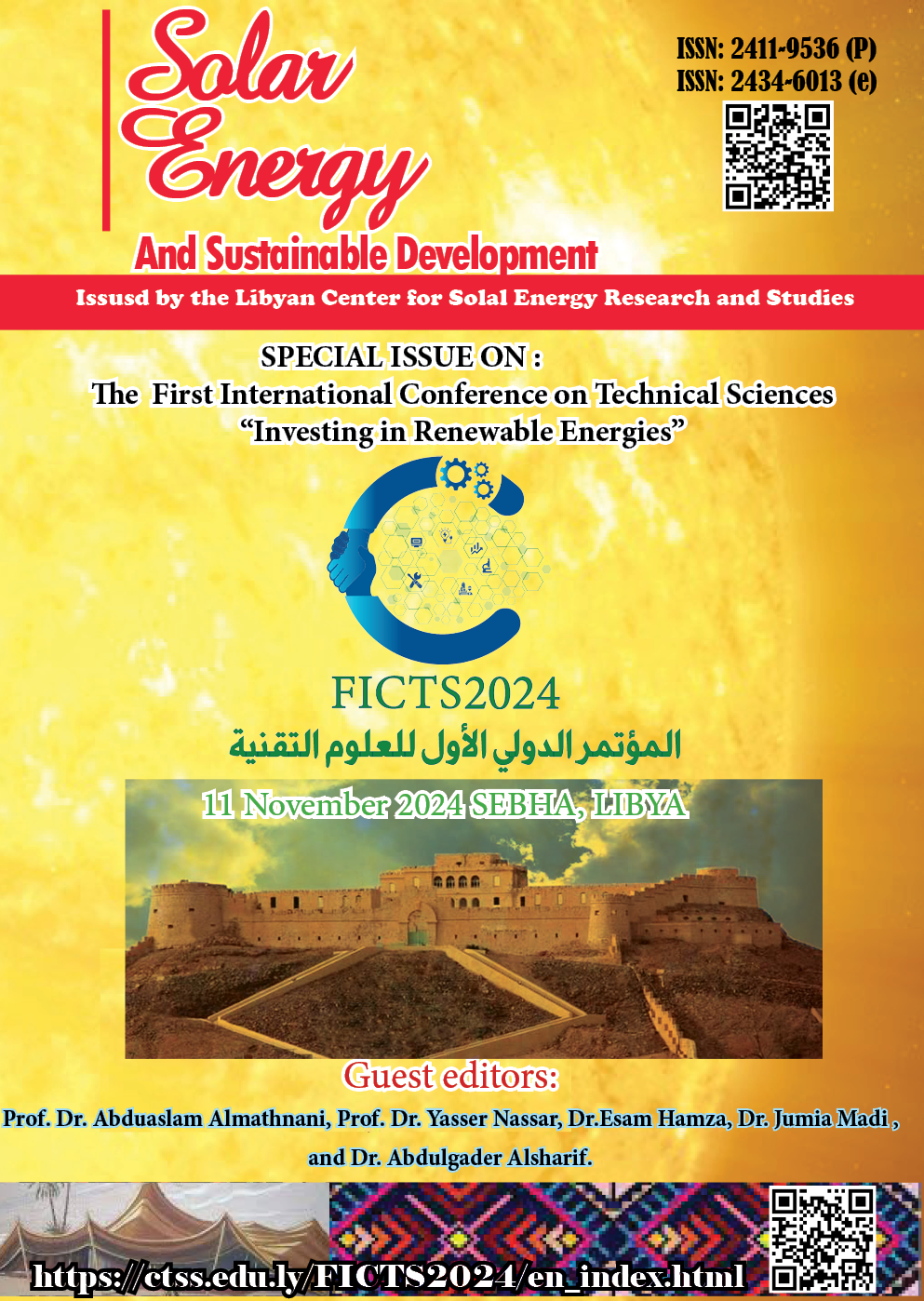Towards Efficient Electricity Management in Benghazi
Forecasting Demand and Load Shedding with ARIMA Models
DOI:
https://doi.org/10.51646/jsesd.v14iFICTS-2024.446Keywords:
Autoregressive Integrated Moving Average, Benghazi Electrical Grid, General Electricity Company of Libya, Load Shedding, Time Series Analysis.Abstract
In Libya, the general electricity company is tasked with managing peak electricity demand, often resorting to load shedding. This practice, while necessary, results in power outages, particularly impacting areas like the Benghazi Electrical Grid. This study aims to bring predictability to these events by exploring time series forecasting models namely: Autoregressive Integrated Moving Average (ARIMA), Seasonal ARIMA (SARIMA), and Dynamic Regression ARIMA (DRARIMA). The models were trained using data from May 2020 and 2021, and subsequently tested on May 2022. Performance was evaluated using metrics such as mean squared error, mean absolute error, mean absolute percentage error, and mean absolute percentage accuracy. The ARIMA model achieved the highest accuracy at 78.88% mean absolute percentage accuracy with a mean absolute error of 0.9. The SARIMA model, which considers seasonal patterns, achieved an accuracy of 73.86% and mean absolute error of 0.11, but its complexity may lead to overfitting. The DRARIMA, which incorporates exogenous variables, demonstrated an accuracy of 65.36% and mean absolute error of 0.15. Future projections for May 2024 and 2025 using ARIMA models indicate potential improvements in load shedding management and highlight the importance of model selection for accurate forecasting. By improving load forecasting accuracy, this research aims to enhance the effectiveness of load shedding management, thereby reducing power outages and their socio-economic impacts in regions like Benghazi. These findings are particularly valuable for energy planners and managers in similar contexts, providing practical insights and data-driven strategies.
Downloads
Metrics
References
El-Khozondar, H.J., et al., A smart energy monitoring system using ESP32 microcontroller. e-Prime - Advances in Electrical Engineering, Electronics and Energy, 2024. 9: p. 100666. DOI: https://doi.org/10.1016/j.prime.2024.100666
(EIA), I.-U.S.E.I.A. Country Analysis Executive Summary: Libya. 2024 9-5-2022 [cited 9-11-2024.
Almaktar, M., M.J.R. Shaaban, and S.E. Reviews, Prospects of renewable energy as a non-rivalry energy alternative in Libya. 2021. 143: p. 110852. DOI: https://doi.org/10.1016/j.rser.2021.110852
Yahya, W., et al., Future study of renewable energy in Libya. 2020. 7(10): p. 1-6. DOI: https://doi.org/10.22161/ijaers.710.1
Ayuk, N., Billions at Play: The Future of African Energy and Doing Deals. 2020: Made For Success Publishing.
Ihbal, A.J.J.o.P. and A. Sciences, Forecasting Short-Term Peak Load Demand in the Libyan Power Grid using Multiple Regression Model. 2023. 22(3): p. 124-128. DOI: https://doi.org/10.51984/jopas.v22i3.2759
Alnaedh, A., A. Matoug, and S. Al-Behadili, Analysis of the Electrical Power Distribution System in Tarhuna City (Libya) to Avoid Future Loads Using NEPLAN Software. Wadi Alshatti University Journal of Pure and Applied Sciences, 2024. 2(1): p. 23-33.
El-Osta, W. and U.J.S.D.R. Elghawi, Assessment of Energy Intensity Indicators in Libya: Case Study. 2020. 2(1): p. p9-p9. DOI: https://doi.org/10.30560/sdr.v2n1p9
Li, L., et al., Impact of natural and social environmental factors on building energy consumption: Based on bibliometrics. 2021. 37: p. 102136. DOI: https://doi.org/10.1016/j.jobe.2020.102136
Huang, Y., et al., Analyzing entropy features in time-series data for pattern recognition in neurological conditions. 2024: p. 102821. DOI: https://doi.org/10.1016/j.artmed.2024.102821
Arumugam, V. and V.J.I. Natarajan, Mesures, Métrologies, Time Series Modeling and Forecasting Using Autoregressive Integrated Moving Average and Seasonal Autoregressive Integrated Moving Average Models. 2023. 22(4). DOI: https://doi.org/10.18280/i2m.220404
Kontopoulou, V.I., et al., A review of ARIMA vs. machine learning approaches for time series forecasting in data driven networks. 2023. 15(8): p. 255. DOI: https://doi.org/10.3390/fi15080255
Kien, D.T., et al., Application of Sarima model in load forecasting in Hanoi city. 2023. 13(3): p. 164-170. DOI: https://doi.org/10.32479/ijeep.14121
Shaqiri, F., R. Korn, and H.-P.J.E. Truong, Dynamic Regression Prediction Models for Customer Specific Electricity Consumption. 2023. 4(2): p. 185-215. DOI: https://doi.org/10.3390/electricity4020012
Chodakowska, E., J. Nazarko, and Ł.J.E. Nazarko, ARIMA Models in Electrical Load Forecasting and Their Robustness to Noise. 2021. DOI: https://doi.org/10.3390/en14237952
Czapaj, R., J.W. Kaminski, and M.J.E. Sołtysik, A Review of Auto-Regressive Methods Applications to Short-Term Demand Forecasting in Power Systems. 2022. DOI: https://doi.org/10.3390/en15186729
López, J.C., M.J. Rider, and Q.J.I.T.o.P.S. Wu, Parsimonious Short-Term Load Forecasting for Optimal Operation Planning of Electrical Distribution Systems. 2019. 34: p. 1427-1437. DOI: https://doi.org/10.1109/TPWRS.2018.2872388
Amerise, I.L. and A.J.E.S. Tarsitano, Point and interval forecasts of electricity demand with Reg-SARMA models. 2021. 14: p. 89-109. DOI: https://doi.org/10.1007/s12667-021-00444-w
Crujido, L.J.C., et al., Day-Ahead Electricity Load Forecasting with Multivariate Time Series. 2023.
Dubey, A.K., et al., Study and analysis of SARIMA and LSTM in forecasting time series data. 2021. 47: p. 101474. DOI: https://doi.org/10.1016/j.seta.2021.101474
Yin, C., et al., SARIMA-Based Medium- and Long-Term Load Forecasting. 2023. DOI: https://doi.org/10.13052/spee1048-5236.4222
Durmus Senyapar, H.N. and A.J.S. Aksoz, Empowering Sustainability: A Consumer-Centric Analysis Based on Advanced Electricity Consumption Predictions. 2024. 16(7): p. 2958. DOI: https://doi.org/10.3390/su16072958
Velasco, L.C.P., et al., A hybrid model of autoregressive integrated moving average and artificial neural network for load forecasting. 2019. 10(11): p. 14-16. DOI: https://doi.org/10.14569/IJACSA.2019.0101103
Kaytez, F.J.E., A hybrid approach based on autoregressive integrated moving average and least-square support vector machine for long-term forecasting of net electricity consumption. 2020. 197: p. 117200. DOI: https://doi.org/10.1016/j.energy.2020.117200
Somu, N., G.R. MR, and K.J.A.E. Ramamritham, A hybrid model for building energy consumption forecasting using long short term memory networks. 2020. 261: p. 114131. DOI: https://doi.org/10.1016/j.apenergy.2019.114131
Gasparin, A., S. Lukovic, and C.J.C.T.o.I.T. Alippi, Deep learning for time series forecasting: The electric load case. 2022. 7(1): p. 1-25. DOI: https://doi.org/10.1049/cit2.12060
Lara-Benítez, P., et al., Temporal convolutional networks applied to energy-related time series forecasting. 2020. 10(7): p. 2322. DOI: https://doi.org/10.3390/app10072322
Farkash, H.M., et al. Medium-term load forecasting for the city of benghazi using an artificial neural network based time series approach. in 2023 IEEE 3rd International Maghreb Meeting of the Conference on Sciences and Techniques of Automatic Control and Computer Engineering (MI-STA). 2023. IEEE. DOI: https://doi.org/10.1109/MI-STA57575.2023.10169598
Ali, S.B., A. Tahir, and B.T.M. Obadi. Application of Voltage Control Techniques in South Western Libyan Network to Enhance Voltage Stability with Future Load Forecasting. in 2022 IEEE 2nd International Maghreb Meeting of the Conference on Sciences and Techniques of Automatic Control and Computer Engineering (MI-STA). 2022. IEEE. DOI: https://doi.org/10.1109/MI-STA54861.2022.9837679
Alarbi, A.A., An innovative residential demand side management method to the Libyan electricity network. 2022, Loughborough University.
Hamouda, A.A., et al., STUDY AND ASSESSMENT OF RESIDENTIAL ELECTRICAL LOAD: A CASE STUDY IN SAWKNAH (SUKNA) CITY-LIBYA. 2021. 5(2).
Chaaraoui, S., et al., Day-ahead electric load forecast for a ghanaian health facility using different algorithms. 2021. 14(2): p. 409. DOI: https://doi.org/10.3390/en14020409
Guefano, S., et al., Forecast of electricity consumption in the Cameroonian residential sector by Grey and vector autoregressive models. 2021. 214: p. 118791. DOI: https://doi.org/10.1016/j.energy.2020.118791
Nti, I.K., et al., Electricity load forecasting: a systematic review. 2020. 7: p. 1-19. DOI: https://doi.org/10.1186/s43067-020-00021-8
Hoffmann, M., et al., A review on time series aggregation methods for energy system models. 2020. 13(3): p. 641. DOI: https://doi.org/10.3390/en13030641
Fan, C., et al., A review on data preprocessing techniques toward efficient and reliable knowledge discovery from building operational data. 2021. 9: p. 652801. DOI: https://doi.org/10.3389/fenrg.2021.652801
Singh, D. and B.J.A.S.C. Singh, Investigating the impact of data normalization on classification performance. 2020. 97: p. 105524. DOI: https://doi.org/10.1016/j.asoc.2019.105524
Herwanto, H.W., et al. Comparison of min-max, z-score and decimal scaling normalization for zoning feature extraction on Javanese character recognition. in 2021 7th International Conference on Electrical, Electronics and Information Engineering (ICEEIE). 2021. IEEE. DOI: https://doi.org/10.1109/ICEEIE52663.2021.9616665
Mulla, S., C.B. Pande, and S.K.J.W.R.M. Singh, Times Series Forecasting of Monthly Rainfall using Seasonal Auto Regressive Integrated Moving Average with EXogenous Variables (SARIMAX) Model. 2024. 38(6): p. 1825-1846. DOI: https://doi.org/10.1007/s11269-024-03756-5
Ramadan, A.I.H.A., et al., Energy communities from municipality level to province level: A comparison using autoregressive integrated moving average model. 2023. 17(8): p. 188-194.
Hossain, M.A., et al., Optimized forecasting model to improve the accuracy of very short-term wind power prediction. 2023. 19(10): p. 10145-10159. DOI: https://doi.org/10.1109/TII.2022.3230726
Riaz, M., et al., Epidemiological Forecasting Models Using ARIMA, SARIMA, and Holt–Winter Multiplicative Approach for Pakistan. 2023. 2023. DOI: https://doi.org/10.1155/2023/8907610
Wang, L.J.O.J.o.S., Time Series Analysis and Prediction of COVID-19 Pandemic Using Dynamic Harmonic Regression Models. 2023. 13(2): p. 222-232. DOI: https://doi.org/10.4236/ojs.2023.132012
Dey, B., et al., Forecasting ethanol demand in India to meet future blending targets: A comparison of ARIMA and various regression models. 2023. 9: p. 411-418. DOI: https://doi.org/10.1016/j.egyr.2022.11.038
Suleiman, M., et al., Modelling Nigeria Crude Oil Prices using ARIMA Time Series Models. 2023. 5(1).
Huang, X. and H.L.J.N.D. Shang, Nonlinear autocorrelation function of functional time series. 2023. 111(3): p. 2537-2554. DOI: https://doi.org/10.1007/s11071-022-07927-0
Weiß, C.H., et al., Partial autocorrelation diagnostics for count time series. 2023. 25(1): p. 105. DOI: https://doi.org/10.3390/e25010105
Katambire, V.N., et al., Forecasting the Traffic Flow by Using ARIMA and LSTM Models: Case of Muhima Junction. 2023. 5(4): p. 616-628. DOI: https://doi.org/10.3390/forecast5040034
Robeson, S.M. and C.J.J.P.o. Willmott, Decomposition of the mean absolute error (MAE) into systematic and unsystematic components. 2023. 18(2): p. e0279774. DOI: https://doi.org/10.1371/journal.pone.0279774
Xiao, R., et al., Predict stock prices with ARIMA and LSTM. 2022.
Ospina, R., et al., An overview of forecast analysis with ARIMA models during the COVID-19 pandemic: Methodology and case study in Brazil. 2023. 11(14): p. 3069. DOI: https://doi.org/10.3390/math11143069
Downloads
Published
How to Cite
Issue
Section
License
Copyright (c) 2025 Solar Energy and Sustainable Development Journal

This work is licensed under a Creative Commons Attribution-NonCommercial 4.0 International License.














